Top News
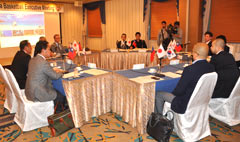
February 18, 2012 Ryukyu Shimpo
On February 17 at Laguna Garden Hotel in Ginowan, officials of professional basketball leagues from Japan (bj), Korea (KBL) and Taiwan (SBL), were invited to attend the East Asia Basketball Executive Meeting held to discuss international exchange among professional basketball teams.
This is a part of a sports and tourism promotion project run by the prefectural government. Professional basketball affiliates from each country exchanged information and opinions about their leagues and discussed the possibility of holding an international tournament and training camps in Okinawa.
Lee Sang Kook from KBL Pusan explained that about five teams currently hold training camps in Tokyo or Osaka, usually in August and September. He said, “If these teams were to have their camps in Okinawa, it might be possible to hold an international tournament. A good training environment and games with competitive teams would be important criteria for holding such a camp.”
Wang Wei Chang from SBL stated, “When I discussed this idea with people from each team in Taiwan before coming to Okinawa, there was a great deal of positive feedback about having games and a training camp here. I think that many teams would be excited about the prospect of coming to Okinawa.”
Commenting that in the small capacity gymnasiums in Okinawa it would be difficult to hold an international tournament at which 3000 to 4000 spectators would attend, Tatsuro Kimura from the Ryukyu Golden Kings, pointed out the need for better facilities.
Toshimitsu Kawachi, the commissioner of the bj league said, “Each league has its own set of circumstances, but it is important to try to do something. I would like to encourage the SBL and KBL to hold camps and an international tournament in Okinawa.”
(English translation by T&CT, Megumi Chibana and Mark Ealey)
Go To Japanese
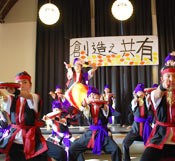
February 20, 2012 Kumiko Hokama, Ryukyu Shimpo
Kiyofumi Tobaru, a teacher dispatched from Okinawa to the Japanese International School in Berlin, will finish his three-year tenure this March but may leave behind the eisa dance sensation in Berlin. The eisa dance performed by his students in the school festival held last November 12 received a great response, and will be performed again at the final event of the International Tourism Bourse Berlin, which starts from March 7.
For the school festival Toyama procured 19 small paranku drums used for eisa, two big odaiko drums, and sticks, and the students’ mothers made costumes using cloth ordered from Okinawa. The students performed the full-scale eisa wearing the costumes.
They danced to two songs, Nenju-Kuduchi by the Rinken Band and Miruku-Munari by Hidekatsu. For students who did not know anything about eisa or Uchinaguchi, Tobaru explained the meaning of the lyrics and lent them videos in which he demonstrated eisa.
Despite the numerous difficulties involved, many students even devoted their free time to practicing the dance, and as a result, they were able to perform it very well on stage and impress the audience. After that, they were invited to perform at a neighboring elementary school and a sister school.
“The students are keen on eisa. Maybe the idea of hitting a drum as they dance attracted the children. Also parents praised them very much. It seems that people were moved by the powerful sound of the paranku and odaiko drums, which is a little different from Japanese traditional arts and is rather exotic.” Tobaru said.
Coincidentally, the date of the final event of the International Tourism Bourse Berlin is March 11. Tomoko Tobaru, Kiyofumi’s wife, who has helped to make the costumes, said, “I hope it will help convey our feelings of gratitude for the assistance offered by people all over the world for victims of the Great East Japan Earthquake and display some of the charm of Japan. I am Okinawan, so I am very proud that we can perform eisa in Germany.”
(English translation by T&CT, Lima Tokumori and Mark Ealey)
Go To Japanese
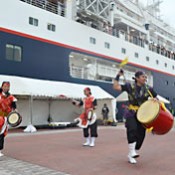
February 17, 2012 Ryukyu Shimpo
On February 16, the first group on the Fly-Cruise Okinawa, a Naha-based cruise tour around the islands off Okinawa, departed from the Wakasa Berth in Naha. At the departure ceremony, the passengers were given a warm send-off with an eisa dance. About 300 passengers from all over Japan will visit Iriomote Island and Zamami Island for four days.
It is a new-style tour called Fly-and-Cruise in which tourists gather at a departure location by airplane then go around sightseeing spots by cruise ship. This is the second tour following on from that of last year.
There are four courses running until the end of February, with the tourists basing themselves out of Naha Port and traveling around Yonaguni Island, Miyako Island and Taiwan on the sightseeing vessel Nippon-maru of the Mitsui O.S.K. Passenger Line. Approximately 1200 people are taking part in the tour, which is about 100 people more than last year.
Yoshiaki Kikuchi, president of JTB Okinawa, which is offering the tour, said, “Similar to the around-islands-cruises in the Caribbean Sea, I hope to open up new sea-routes using Naha Port more and more as the home-port.”
(English translation by T&CT, Lima Tokumori and Mark Ealey)
Go To Japanese
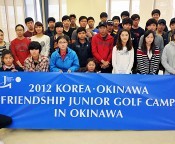
February 16, 2012 Ryukyu Shimpo
The Korea-Okinawa Friendship Junior Golf Camp in Okinawa, in which junior golfers from Okinawa and Korea practice and play together, started at 6:30am on February 16 at the Kanucha Golf Course. By February 15, 30 Korean junior players from the first grade of junior high school to the third grade of high school had arrived at Okinawa.
Organized by the Okinawa-ken Golf Association and the Ryukyu Shimpo, the camp was held for the first time as a 2011 Sports Tourism Strategic Project sponsored by the Okinawa Prefectural Government. The aim is to get people from Korea to understand that Okinawa is warm even in winter and is well suited to golf-camps, and also that the level of junior players will improve through such interaction.
On February 15, the players went from Naha Airport to the Ryukyu Shimpo offices for a reception. Director of the Project Division Satoshi Ikema welcomed them, saying, “I hope that exchange with Okinawan players will see you make progress both technically and mentally.”
Jae-Won Jang, a third grade high school student said, “I wanted to play golf in Japan and so I applied to come. I’m good at approach-shots, but my iron-shot is inconsistent, so I want to improve that aspect of my game during the camp.”
Yong-Jun In, a third grade junior high school student who has played golf since she was in the sixth grade at elementary school, said, “Okinawa is hot” and said, “I want to make some Japanese friends through this camp.”
The Korean players will stay in Okinawa for about two weeks until February 27. They plan to play practice rounds on golf courses in Nago, Naha and Itoman before holding the second lot of games on February 23 at the Palm Hills Golf Resort in Itoman. In the second games, 60 junior players from Okinawa will also participate.
Professional golfers Mi-Jeong Jeon and Ayako Uehara are scheduled to give lessons on February 26 at the Naminoue Golf Range.
(English translation by T&CT, Lima Tokumori and Mark Ealey)
Go To Japanese
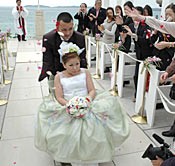
February 16, 2012 Ryukyu Shimpo
On January 5, a wedding show entitled “Bride in a Wheelchair” was held at the CanNa Resort Villa in Ginoza. About 150 guests enjoyed a simulated wedding ceremony and a fashion show in which dresses specifically designed for wheelchair users were introduced.
The hotel arranged the event using the theme of “Happy wedding ceremony for the physically-challenged.” It was carried out using a prefectural government subsidy provided under the “Genki project.” Respecting the individual’s personality, art designer Norimitsu Yabu worked on top-bottom-separated wedding dresses that are easy to put on and take off.
In the event, “bride” 22 year-old Nodoka Kikugawa in a wheelchair and “bridegroom” 26 year-old Tsubasa Kikugawa appeared as models. The couple had held their own wedding in the hotel in January. Nodoka said, “It was difficult to find a barrier-free hotel, but CanNa Resort Villa is a completely barrier-free facility, even including the wedding chapel, so we chose to have our wedding here.” Tsubasa said, “I used to be a care worker, so I have many friends who use wheelchairs. I think barrier-free weddings are a nice option for the elderly too.”
Members of Barrier Free Network,NPO also appeared in the fashion show. The audience enjoyed the dresses that seemed to accentuate each of the model’s personality.
(English translation by T&CT, Shinako Oyakawa and Mark Ealey)
Go To Japanese
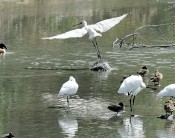
February 15, 2012 Photograph by Hiroaki Yamashiro
A high-pressure zone over the Okinawa region on February 14 brought blue skies and a summer-like day. A temperature of 26.5 degrees was recorded at Hateruma and on the Iriomote Islands, and in Naha it was 25 degrees, the sort of temperatures normally experienced in late April.
In the flood-control basin of Yone, Tomigusuku, ten black-faced spoonbills, an endangered species that had flown in during the winter, rested their wings as they bathed in the sunshine and pecked away looking for food.
According to the Okinawa Meteorological Observatory, over the coming week clouds will spread due to a trough of low-pressure, which will cause temperatures to drop, bringing rain in some areas.
(English translation by T&CT, Mark Ealey)
Go To Japanese

Go To Video
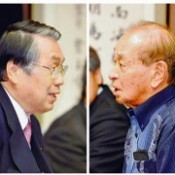
February 19, 2012 Ryukyu Shimpo
In the afternoon of February 18, Defense Minister Naoki Tanaka visited the Second Futenma Elementary School, which is located adjacent to U.S. Marine Corps Air Station Futenma. In response to principal Harumi Chinen’s request that something be done to remove the dangers that Futenma Air Station poses, Tanaka stated, “The air station will definitely not be allowed to become a permanent fixture here.” Defense Minister Tanaka, who was making his second visit to Okinawa since taking up office, met Okinawa Governor Hirokazu Nakaima at the Okinawa Prefectural Government Office late in the afternoon of that same day to discuss issues regarding the return and relocation of Futenma Air Station. Tanaka reported that the government has begun consultations to review the 2006 Japan-U.S. accord on the realignment of U.S. forces in Japan, stating, “It is a priority for the central government to reduce the burden on Okinawa as soon as possible, but at the same time maintain deterrence.” On the basis that the Japanese and U.S. governments have decided to uncouple the issue of the relocation of Futenma Air Station from that of the transfer of the Marines in Okinawa to Guam, Nakaima stated, “This base just cannot be left its present location. We want it moved as soon as possible.”
After the meeting, Nakaima said, “The central government is determined to relocate the base to Henoko in Nago, but I want the minister to understand that that will be extremely difficult.” Nakaima reiterated his views on the current relocation plan, but he did not repeat his request for the relocation of the base out of Okinawa, stating that, “The opportunity to say that did not arise today.”
The meeting lasted 25 minutes and was held behind closed doors except for the opening remarks. Although the Ministry of Defense explained about the review of the realignment of U.S. forces in Japan, they did not go as far as to mention specific details, such as the schedule for the return of military facilities and land occupied by the U.S. military south of the U.S. Air Force’s Kadena base. They also did not mention how they would deal with Okinawa Defense Bureau chief Ro Manabe, who drew up a list of bureau employees and their relatives living in Ginowan ahead of the mayoral election in the city and lectured his staff, calling for them to vote.
After the meeting, Tanaka talked to the press, saying, “I said that the central government will not allow Futenma Air Station to become a permanent fixture.” On that basis, he asserted that there would be no change in the policy with regard to the current relocation plan, saying, “The Japanese and the U.S. governments intend to implement the Japan-U.S. accord on the premise that the relocation of Futenma Air Station to Henoko is the best course of action.”
With regard to reviewing the realignment of U.S. forces in Japan, Nakaima said, “Although we appreciate the central government’s efforts to begin consultation on this, we would like to see some tangible results. They have not provided us with any clear results regarding the reduction of noise generated by U.S. military aircraft, so I will be looking closely to see what actually comes of this.”
Tanaka met Chinen and the new Ginowan mayor Atsushi Sakima at the Second Futenma Elementary School.
(English translation by T&CT, Mark Ealey)
Go To Japanese

Go To Video
February 15, 2012 Ryukyu Shimpo
With regard to U.S. military personnel training with firearms near the Camp Kinser perimeter fence beside Route 58 in Urasoe, Camp Kinser commander, Colonel John E. Kasperski, visited Urasoe Mayor Mitsuo Gima at the Urasoe Municipal Office on February 15. Colonel Kasperski admitted that the training in question was conducted in an area of the camp in which such activities are prohibited and apologized for causing concern among local residents.
(English translation by T&CT, Mark Ealey)
Go To Japanese
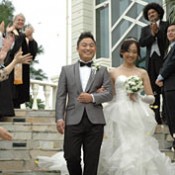
February 14, 2012 Ryukyu Shimpo
On February 13, at the ANA Intercontinental Manza Beach Resort in Onna, a wedding ceremony was held for nine Chinese couples invited to take part in a tour planned by the Okinawa Prefectural Government (OPG). The ceremony will be broadcast by the Chinese media, which was also invited to join the tour and will be shown on Air China flights to promote resort weddings in Okinawa.
The OPG, the Okinawa Convention and Visitors Bureau, Air China and the Okinawa Watabe Wedding (Naha) worked together to organize the tour. Participants were recruited using the Sina Microblog Weibo, to which they post comments during the tour. The OPG and others plan to make a short movie set in Okinawa in which a popular Chinese entertainer will appear, and then make that movie available for viewing on Weibo.
Newly weds who took part in the tour said, “The sea around Okinawa is the most beautiful we have ever seen in the islands we have visited. We are going to recommend it our friends.”
(English translation by T&CT, Lima Tokumori and Mark Ealey)
Go To Japanese
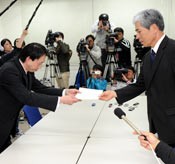
February 21, 2012 Ryukyu Shimpo
In the afternoon of February 20, in keeping with the regulations governing the environmental impact assessment report (EIA) submitted by the Okinawa Defense Bureau to the Okinawa Prefectural Government (OPG) last December on the plan to construct an alternative facility for the relocation of Futenma Air Station to Henoko, Nago, Governor of Okinawa Hirokazu Nakaima submitted a written statement of opinion on the EIA to the Okinawa Defense Bureau.
In the statement, Nakaima firmly pointed out that the current plan to construct an alternative facility at Henoko poses serious problems for the environment. The statement concluded that it would be impossible for the environmental protection policy and other measures proposed by the government in the EIA to properly conserve the living environment and natural environment around the area in question. In the preamble, Nakaima reiterated the position of the OPG, which has repeatedly demanded the relocation of Futenma Air Station out of Okinawa and an early return of the land used by the base.
With regard to the planned relocation to Henoko, Nakaima emphasized the position of the OPG, stating, “It will be impossible to implement a relocation plan that will not obtain local consent, and moving the facilities at Futenma to some other part of Japan is a logical and swift solution.”
Nakaima also pointed out that there are 175 problems in the government’s assessment report in 25 areas such as the impact on the habitat of the dugong, an endangered marine mammal, and the planned deployment to Futenma beyond this summer of the MV-22 Osprey vertical takeoff and landing aircraft.
The EIA includes the Osprey among the aircraft scheduled to operate out of the alternative facility. Changes have subsequently been made in the flight path for these aircraft, which impacts upon all of the noise levels for surrounding residential areas. Nakaima expressed strong dissatisfaction with the EIA, stating, “I am greatly concerned that important environmental information in the EIA being changed at the final stage of the assessment process could create a precedent in the system.”
In the press conference, Hiroshi Shimoji, the head of the Okinawa Prefectural Government Department of Environmental and Community Affairs, claimed that under the current plan it would be impossible to protect the environment around the envisaged relocation site, saying, “Although the central government has said that there are no problems in terms of environmental conservation, without scientific data this assessment report is hard to accept.”
The OPG is scheduled to submit its opinion on the reclamation aspect of the relocation project to the Okinawa Defense Bureau by March 27.
The central government can revise its assessment report based on the governor’s opinion, but drastic changes could have a major impact on the current relocation plan. The central government makes amendments, which will be officially announced and inspected, and with that, the evaluation assessment process is complete.
It was pointed out that it is possible that in June the central government will apply to the OPG for approval of the land reclamation work, but Foreign Minister Koichiro Gemba has indicated that the government’s request for permission may be put back to this autumn or later.
(English translation by T&CT, Mark Ealey)
Go To Japanese

Go To Video
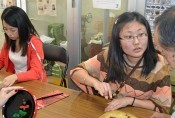
February 12, 2012 Ryukyu Shimpo
On February 11, at the Naha City Traditional Arts and Crafts Center in Tenbusu, Naha, a total of 16 university students and members of a TV crew from Dalian in Liaoning Province who are visiting Okinawa from February 7 on the Okinawa Culture Experience Ryugaku Tour, experienced dyeing textile and the weaving of bingata stencil dyed fabric. Ryugaku Tour: Learn in Ryukyu is a new experience-based tourist option that combines Okinawan culture and sightseeing. Their experience will be filmed and edited as a TV program to be broadcasted in the Liaoning Province in March. It is hoped that the program will help raise the profile of Okinawa in that part of China.
A female student from Dalian University, tried her hand at dyeing textiles and was pleased with what she managed to produce, “There is a similar craft to this in China, but this is the first time for me to experience this. It was a lot fun.”
President of Southern Cross Road, Yasunobu Kawasaki, who accompanied the members of the tour said, “This tour has really given me a feel for the potential of culture-tourism. In the near future, I would like to plan tours for Chinese university seminar groups.”
The tour is part of the Genki Project, in which the Prefectural Government promotes the development of new tourism options.
The group has enjoyed the tour since February 11, experiencing an exchange meeting with students from Meio University and going snorkeling.
Marketing Director Tsukasa Higa, from the Naha City Traditional Arts and Crafts Center, said, “I hope that the visitors experience the cultural connection between Okinawa and China, and that this leads to increased exchanges between both sides.”
(English translation by T&CT, Megumi Chibana and Mark Ealey)
Go To Japanese













 Webcam(Kokusai Street)
Webcam(Kokusai Street)


